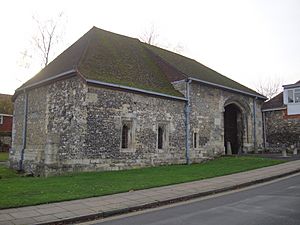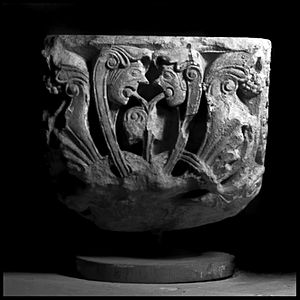Hyde Abbey facts for kids
Hyde Abbey was a large Benedictine monastery located just outside the city walls of Winchester, Hampshire, England. It was a very important religious site during the Middle Ages. However, in 1538, King Henry VIII ordered that monasteries and abbeys, including Hyde Abbey, be closed down and taken apart.
Contents
The Abbey's Early History
When Alfred the Great rebuilt the city of Winchester around 880, the main church and royal palace were in the city center. As Winchester grew, King Alfred bought land to build a new church, called the New Minster. This new church was finished around 903. A wise monk named Grimbald became its first abbot. King Alfred's body was moved and buried there.
Other members of the royal family were also buried at the New Minster. In 1041, Queen Emma, who was King Cnut's widow, gave the church the head of Saint Valentine. This was considered one of the most valuable treasures of the Benedictine monks there.
Moving to Hyde Mead
In 1109, King Henry I ordered the New Minster to move to a new spot called Hyde Mead. This was just outside the city walls, to the north. The new abbey church at Hyde was ready in 1110. The bodies of King Alfred, his wife Ealhswith, and his son Edward the Elder were carried in a grand procession through Winchester. They were reburied in front of the main altar at Hyde Abbey. Because these important royals were buried there, Hyde Abbey became a popular place for pilgrimage (religious journeys).
Challenges and Changes
In 1141, the abbey church was damaged. This happened when Winchester was burned during a big fight called The Anarchy. This conflict was between supporters of King Stephen and Matilda over who should rule England. The abbey had to be rebuilt after this damage.
Afterward, the abbey became very successful and owned a lot of land nearby. But this changed in 1539 when King Henry VIII ordered the dissolution of the monasteries. This meant many religious houses were closed. Hyde Abbey was dissolved, and the monks who lived there were given pensions. The abbey buildings were quickly taken apart so their materials could be used for other things. Some important books from the abbey's library survived, like a cartulary (a book of records), a breviary (a prayer book), and the Liber vitae (a book listing people the monks remembered in prayer).
Just three years later, in 1542, a historian named John Leland visited the site. He wrote that the great abbey of Hyde was already gone. He noted that the bones of King Alfred and his son Edward had been moved from the New Minster and buried in a tomb before the high altar at Hyde.
What Happened to the Site?
For about 250 years, from 1538 to 1788, the part of Hyde Abbey where Alfred and his family were buried was slowly forgotten. Other parts of the abbey grounds were developed. For example, one corner became a large house. The lower eastern area, near the stream, seemed to become mostly rough grazing land, though there were also piles of rubble.
In 1788, the county decided to build a small local prison on the land. As prisoners dug the foundations, they started finding many old graves on the abbey site. A local Catholic priest, Dr. Milner, saw what was happening. He wrote about how many stone coffins were dug up. They also found interesting items like chalices (cups), patens (plates), rings, buckles, pieces of leather shoes, and even parts of beautiful gold-plated croziers (staffs carried by bishops).
Today, only a few parts of Hyde Abbey remain. You can still see the gatehouse, which was the entrance to the abbey grounds. There's also an arch that once went over the abbey millstream. The church that was built for pilgrims and lay-brothers is now part of St Bartholomew's Parish Church.
Important Burials
- Alfred the Great (his exact burial spot is now lost)
- Edward the Elder
- Ealhswith
Finding Out More: Archeological Digs
In the 19th century, a local expert dug around the site. He believed he found the remains of King Alfred the Great. He said that Alfred's burial place had been searched for valuables. The bones were then reburied in a simple grave outside St Bartholomew's church, Hyde.
More archaeological digs happened in 1999. The teams dug four trenches to learn as much as possible about the eastern end of the Abbey Church. They found evidence of two building phases. The church built in 1110 was made of flint and chalk rubble. The choir area was separated from the ambulatory (a walkway around the altar). Pilgrims would walk along this ambulatory to visit shrines and chapels at the east end of the church. One chapel, shaped like a small rectangle with a rounded end (apsidal), was found on the south side. Part of another similar chapel was found to the north.
The original eastern chapel of the 1110 church was rebuilt in the late 12th or early 13th century. The new part was made of a light, honey-colored limestone. It seems the old chapel stayed standing while the new one was built. It was then taken down once the new work was finished. This might have been done to avoid stopping church services.
Right in front of where the main altar would have been, archaeologists found several deep, overlapping pits. These pits show that people had tried many times in the past to find the tomb of Alfred the Great. When the Abbey was dissolved in 1539, it was said that small lead tablets with the names Alfred and Edward were found in graves in front of the high altar. No archaeological proof of this first search remains, but later discoveries suggest the graves were left mostly untouched. Within a year, the church and cloisters were destroyed, and the church site was lost. However, maps from the late 1700s show that the site was covered with piles of rubble.
A few years after the prison was built, Captain Howard, a well-known historian, visited the site. He knew about the discoveries made when King Henry VIII's men were there. He spoke with Mr. Page, the Prison Warden. Mr. Page told him that during work in the Governor's garden, the site of the high altar was found. Three graves were located in front of it.
The coffin believed to be Alfred's was made from a single stone block covered with lead. Mr. Page also told him what happened to it: the prisoners threw the bones around, broke the coffin, and sold the lead. Then, the original grave pit was dug deeper, down to the water level, and the broken coffin was reburied. The earliest pit found in the area matches Mr. Page's description well. It stretched across the entire high altar area and had been dug down to the water table. There were also small clues of earlier cuts that might have been the three royal tombs.
Land Owned by the Abbey
In 1086, a record called the Domesday Book showed that Hyde Abbey owned land in places like Addeston, Collingbourne, Pewsey, Manningford, and Chisledon. You can still see the abbey's connection in names like "Collingbourne Abbot's" (its old name) and "Manningford Abbots" today.



